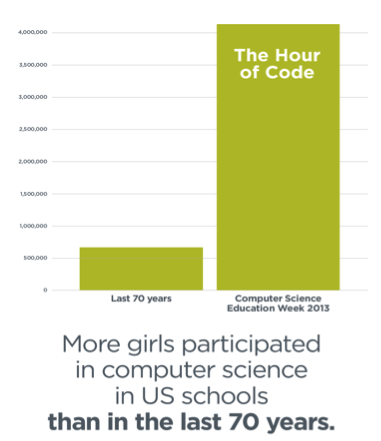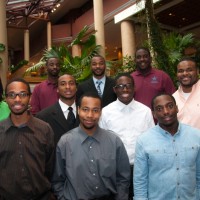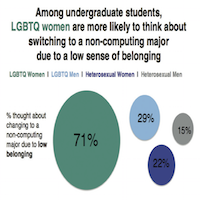Expanding the Pipeline: The Movement to Change the Face of CS Education is Growing
Code.org began almost three years ago with a mission to change the face of computer science (CS) education. In 2013, we started with a short film that went viral. Since then we’ve been building a start-up nonprofit organization working to give every student in every school the opportunity to learn foundational computer science skills. We’ve seen phenomenal results and impact from this mission:
- 300-plus organizations have joined forces to solve this problem.
- More than 70 school districts have embraced CS, including New York, Los Angeles, Chicago, Miami, Las Vegas, Houston, and San Francisco.
- 15,000 teachers have been trained to teach CS; 85 percent of them are female.
- More than 10 percent of all U.S. students in grades K-8 have begun coding; 43 percent of these students are girls.
- 16 states have adopted graduation policies involving CS.
Code.org is dedicated to data-driven decision-making and research-based evaluation of our programs. We’re pleased to share the results of our internal evaluation with the CS education community in an effort to contribute to the conversation about what works, and what doesn’t, in building a more diverse pipeline for CS. We highlight some results below, but you can find our full evaluation report at https://code.org/about/evaluation.
The Hour of Code: Removing Barriers to Entry
Code.org has a number of different but related programs that drive these results and more. We are perhaps most well known for the Hour of Code, a campaign that drives awareness and excitement about coding across the globe by challenging new learners of all ages to study the basics of computer science through fun, interactive one-hour tutorials. We’ve reached more than 100 million students worldwide with the message that “Anyone can learn” to code. And the students we’re reaching are not your stereotypical programmers. During last year’s Hour of Code campaign, more girls participated in CS during that one week than had done so in the previous 70 years.
Professional Development Programs: Transforming Teacher Practice
Code.org’s work goes far beyond the Hour of Code. We are working to create and scale full computer science courses for all K-12 grade levels. We have prepared 11,000 new computer science teachers and reached 6 million students over the past year. We partner with Outlier Research & Evaluation at the University of Chicago, a third-party evaluator, to gauge the impact of these programs. Operating at this scale has yielded many successes. For example, 98 percent of teachers recommend our professional development, and hundreds of thousands of students have demonstrated coding proficiency on our online learning platform. But challenges remain, whether in our professional development workshops, in our school district partnerships, or in improving students’ learning outcomes.
All of our teacher professional development programs are designed around our Professional Development philosophy, which ensures we incorporate self-directed, blended learning into more traditional face-to-face teacher training. The population of teachers we are training through our teacher training work is heterogeneous and diverse in terms of prior experience. Participants vary widely in terms of both their knowledge related to computer science and their skill level for teaching computer science (based on self-reported evaluations).
 Our evaluations shows we’ve been able to engage a large number of teachers in our professional development program from a wide variety of demographic and academic backgrounds. The vast majority of teachers who participate in our professional development leave feeling satisfied and prepared to bring computer science to their students.
Our evaluations shows we’ve been able to engage a large number of teachers in our professional development program from a wide variety of demographic and academic backgrounds. The vast majority of teachers who participate in our professional development leave feeling satisfied and prepared to bring computer science to their students.
However, after their training, teacher implementation of computer science curriculum varies widely. And we’re working to better engage teachers in ongoing professional development over time.
This finding is not unique to Code.org, nor is it unique to computer science. But we’re focused on improving teacher retention as we go forward.
Partnerships and Policy: Building Local Leadership and Capacity
 In order to deploy our teacher training programs, Code.org has partnered with more than 70 districts across the United States. The partnership relationship includes planning, coaching, and sustainability work.
In order to deploy our teacher training programs, Code.org has partnered with more than 70 districts across the United States. The partnership relationship includes planning, coaching, and sustainability work.
In studying the effectiveness of our partnership programs, we found that Code.org has greatly increased the priority of computer science in the partner districts. However, long-term sustainability of gains made through district partnerships is a top concern, for the following reasons:
- District leaders face many challenges in making computer science a priority and implementing Code.org programs, including getting state-level buy-in, securing the necessary infrastructure and funds, integrating CS into the schedule and graduation requirements, and finding and supporting qualified teachers.
- District leaders see a need to engage the broader local community in this effort, including guidance counselors, higher education institutions, and industry.
- Current district leaders do not have actionable plans to sustain their computer science efforts, even though they intend to do so.
Overall, we are encouraged to see that we are helping districts increase the priority of computer science locally in the face of some big challenges, such as infrastructure, funding, competing graduation requirements, and continued teacher development. District planning for sustainability is the current need and focus of future evaluation work.
In an effort to create school-wide buy-in and support for our district partnerships, Code.org held one-day professional development sessions for school administrators and counselors in fall 2014. Our evaluation demonstrates:
- Respondents believe that computer science is necessary for high school students, but feel less strongly that it should be required.
- Respondents reported that the professional development “somewhat” influenced their values and beliefs about computer science and computer science education for students. The counselors reported a statistically significantly higher influence than the administrators.
- Nearly one-third of all respondents felt that their school did not have the resources (materials, CS content, and instructional strategy support) necessary to teach computer science.
Further study of the relationship between administrator and counselor attitudes and sustainable implementation of CS curricula is warranted.
 What’s Next?
What’s Next?
We’re currently analyzing the full results of our professional development evaluation and making plans to iteratively improve our programs over time.
While we are proud of what we’ve accomplished over the past year, we recognize that there is still much work to be done, and are making changes to improve the experience of students and teachers. We’re hoping to leverage the results of this evaluation work to continue improving the diversity of CS education in the coming years. Key questions to be researched and addressed include:
- How can we engage teachers in long-term, transformational training?
- How can we rapidly grow the CS educator community?
- How can we increase teacher retention and improve implementation?
- What types of professional development designs—online, in person, blended—are most effective for meeting the specific needs of teachers who are certified in other subjects but new to teaching CS?
In the meantime, let us know: How can we band together to address these challenges, so that all young people benefit? Tell us your thoughts on Twitter (@teachcode) or on the open CS Education discussion forum on Facebook. And be sure to join us in celebrating this year’s Hour of Code during CSEdWeek. You can learn more and sign up at http://hourofcode.com.
—-
Melissa Jones leads Code.org’s teacher professional learning community.









